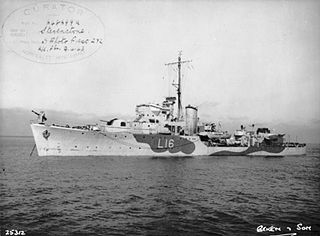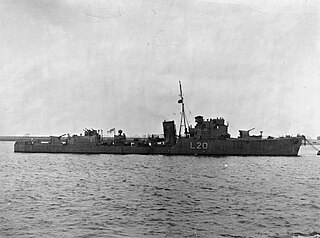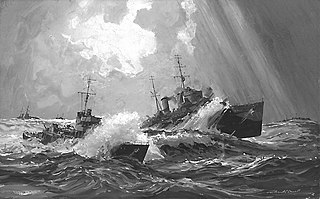
HMS Bramham (L51) was a Hunt-class destroyer of the Royal Navy laid down in Alexander Stephen and Sons shipyards Govan, Scotland on 7 April 1941. She was launched on 29 January 1942 and commissioned into the Royal Navy on 16 June 1942. She was named after the Bramham Moor Hunt and has been the only Royal Navy warship to bear the name. She was adopted by the town of Beverley in the East Riding of Yorkshire during the Warship Week savings campaign of 1942.

Adrias was a Type III Hunt-class destroyer that was originally built for the Royal Navy as HMS Border but never commissioned. Before her completion, she was loaned to the Royal Hellenic Navy on 20 July 1942 and commissioned as Adrias on 5 August 1942 in order to relieve heavy losses of ships sustained by the Royal Hellenic Navy during the German invasion of 1941 and throughout the war. Adrias took her name from the ancient Greek town of Adria in Italy, at the mouth of the Po river, after which the Adriatic Sea is named.

HMS Tetcott was a Type II British Hunt-class destroyer built for the Royal Navy during World War II. She was the only Royal Navy ship to be named after the Tetcott fox hunt.

HMS Zetland was a Royal Navy Type II Hunt-class destroyer, named after the Zetland Hunt.

HMS Wensleydale was a Hunt-class destroyer of the Royal Navy. She was a member of the third subgroup of the class, and saw service in the Second World War. She was adopted by the civil community of Swinton and Pendlebury during Warship Week in 1942. As good luck she carried fox pads from the Wensydale Hounds gifted by the Chapman family of Thronton Rust, Wenslydae.

HMS Brecon was a Hunt-class destroyer of the Royal Navy that saw service in World War II, one of two ships in the fourth subgroup of the class, built to a radically different design from other ships in the Hunt class.

HMS Stevenstone was a Hunt-class destroyer of the Royal Navy. She was a member of the third subgroup of the class, and saw service in the Second World War. All the ships of this class were named after British fox hunts. She was the first Royal Navy warship with this name, after the Stevenstone hunt in Devon.

HMS Brocklesby was a Type I Hunt-class destroyer of the Royal Navy. She served during the Second World War, spending much of the time in the English Channel and Mediterranean, taking part in the Dieppe Raid in 1942, and the Allied landings in Sicily and at Salerno in 1943. After the war, she was used as a sonar trials ship until 1963, and was sold for scrap in 1968.

HMS Berkeley was a Type I Hunt-class destroyer of the Royal Navy. She was a member of the first subgroup of the Hunt class and saw service in World War II before being bombed at Dieppe and then scuttled by HMS Albrighton.

HMS Cattistock (L35) was a Type I Hunt-class destroyer of the Royal Navy. She was a member of the first subgroup of the Hunt class and served throughout World War II before being scrapped in 1957.

HMS Meynell was a Type I Hunt-class destroyer of the Royal Navy which served in World War II. She was sold to Ecuador in 1954 where she served as Presidente Velasco Ibarra.

HMS Garth was a Type I Hunt-class destroyer of the Royal Navy built by John Brown & Company on the River Clyde, and launched on 28 December 1939. She was adopted by the Civil Community of Wokingham, Berkshire, as part of the Warship Week campaign in 1942.

HMS Pytchley was a Type I Hunt-class destroyer of the Royal Navy which served in World War II. She was scrapped in 1956.

HMS Farndale was a Type 2 Hunt-class destroyer of the Royal Navy which served in World War II. She was scrapped in 1962. She was the only British warship so far to bear this name.

HMS Wilton was a Type 2 Hunt-class destroyer of the Royal Navy that served in the Second World War.

HMS Lauderdale was a Hunt-class destroyer of the Royal Navy. Ships of this class were designed as cheap, easily built vessels for convoy escort and antisubmarine duties. She was named like her sisters after a fox hunt, in her case one in Berwickshire. War bonds were issued to finance the building of warships. During Warship Week held in 1942 the civil community of Berwickshire adopted the ship. She has been the only Royal Navy warship to carry this name.

HMS Belvoir was a Hunt-class destroyer of the Royal Navy. She was a member of the third subgroup of the class, and saw service in the Second World War. She was adopted by the civil community of Sutton in Ashfield, Nottinghamshire during Warship Week in 1942.

HMS Melbreak was a Hunt-class destroyer of the Royal Navy. She was a member of the third subgroup of the class, and saw service in the Second World War. All the ships of this class were named after British fox hunts. She was the first Royal Navy warship with this name, after the Melbreak hunt in Cumbria. In 1942 she was adopted by the civil community of Cockermouth in Cumberland, as part of Warship Week.

HMS Bleasdale was a Hunt-class destroyer of the Royal Navy. She was a member of the third subgroup of the class, and saw service in the Second World War. All the ships of this class were named after British fox hunts. She was the first Royal Navy warship with this name, after the Bleasdale hunt in Lancashire. In 1942 she was adopted by the civil community of Garstang in Lancashire, as part of Warship Week.

HMS Limbourne (L57) was a Hunt-class escort destroyer, operated by the Royal Navy. She was sunk in action, off German-occupied Guernsey, on 23 October 1943.




















